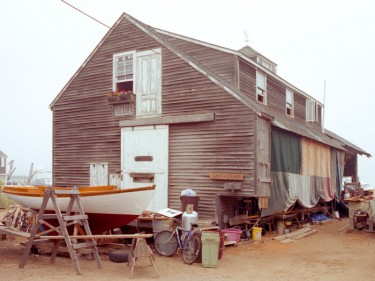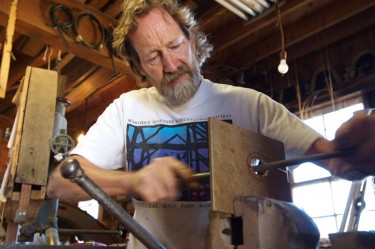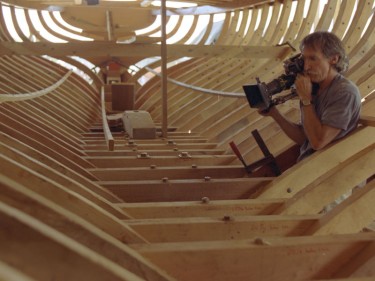 Back to selection
Back to selection
Director Jeff Kusama-Hinte on Charlotte

We are filmmakers. We are artisans.
Or so we forget.
With filmmaking so often abstracted from the actual work of making a film, so enmeshed in conversations about new models and plans and strategies, we sometimes lose touch with what should be the main reason we make movies in the first place: to take pride in works of art made beautifully and with love.
It is precisely the love of artisanal creation that is celebrated in Jeffrey Kusama-Hinte’s Charlotte: A Wooden Boat Story, a verite doc chronicling the making of a 50-foot gaff rigged schooner, “Charlotte,” by a team of craftsmen working in a Martha’s Vineyard Boatyard. Focusing particularly on boat builder Nat Benjamin, Kusama-Hinte observes the painstaking and quiet work involved in building such an elegant craft over the several years required. In doing so, he eschews many of today’s accepted documentary strategies — pinning narrative on conflict, or allowing a character-based story to assume center stage. Instead, Kusama-Hinte focuses on the work, and he pushes us, the audience, to concentrate on its pleasures as well as its vexations, on the focus required to sustain it and the quiet satisfaction achieved by its final completion. With a lovely, Satie-like score by Paul Brill, Charlotte has a gentle, meditative power.
Charlotte is the second feature by Kusama-Hinte, whose Soul Power documentary was half glorious concert film and half exhilarating behind-the-scenes chronicle of the famed concert accompanying the “Rumble in the Jumble” boxing match. The two films are quite different, but they share a respect for their subject matters and a resolve to find the cinematic styles most suited to them. Kusama-Hinte is also a well known producer, whose credits include The Kids are All Right, Thirteen and Mysterious Skin, as well as — full disclosure — the Board Chair of IFP, the publisher of Filmmaker.
I spoke to Kusama-Hinte about making Charlotte, the work required to place it before audiences, and the DIY techniques he’s using to promote and distribute it.
Filmmaker: So, tell me about how you began this documentary, Charlotte.
Kusama-Hinte: I started this film in 2005. Actually, I started this film around 2000 in the sense that that was when I met the people at the boatyard, Nat Benjamin in particular. I started thinking about how one could take the boatyard and convert it into a film experience. And what I found there was so attractive — people doing what they love, displaying really amazing craftsmanship and producing something that is both artistic and timeless. All those things attracted me, but none of those things led to an obvious way to make a film. So I hesitated for a number of years, and then the person who I had talked to about becoming a DP called me while I was on location on another film. He said, “You know, Nat’s actually gonna be building his own boat, a 50-foot schooner, [Charlotte].” I saw that this could be the framework for the film. Then, over a number of years, we just documented the building of the boat, what happened in the boatyard, the archeology of the process and the people and community that made it possible.
Filmmaker: When you began Soul Power, the footage existed, so you knew all the drama that was in that footage — the drama of the musicians, the tension of whether the show was gonna come off or not, etc. But with this film, your subject is a quiet guy who doesn’t get divorced in the movie, and doesn’t have a split with his business partner. He has no health issues, and the bank doesn’t foreclose on his shipyard. Were you worried about the seeming lack of external drama?
Kusama-Hinte: Well this is why I waited five years — to position myself to see what I was going to grab onto. Finally I just decided I had to be true to myself and that if something transpired, I’d be there to get it. But what I was genuinely interested in was the everyday unfolding of the work and what animates that — what makes that possible, what the results are, how it makes people feel and all the rest. So, ultimately, that five-year process was just me coming to grips with the fact that I wasn’t going have a dramatic fulcrum for the film and accepting that. There is the smaller drama, which is the launching of the boat, and there are these particularly funny or outrageous moments that you couldn’t have predicted; they just happened. I watched a lot of [Frederick] Wiseman films to give me the confidence to just say, “I can make the film I want to make.”
Filmmaker: When you made that decision to not worry as much about external drama, what then, held your interest as a filmmaker? What was a surprise or revelation to you?
Kusama-Hinte: I was very fixated on the physicality of the craft and the process, but really, I think, what was most impressive to me was community, the mutual system of support, importance of family, and the importance of mentorship. The preservation, dissemination and transfer of knowledge and skills from generation to generation. These are the things that really began to resonate. I think those values are so important and are actually kind of kind of “future values” as well. They’re 19th century values about know-how, autonomy and being able to do simple and elegant things with local resources, and they are also, in some ways, the future as we’ve overburdened ourselves with pollution, “properly” made objects that break and become obsolete overnight and coming to terms with finite resources. For me, it was quite an odyssey. The film itself is done as a verite film, and I believe it has all these layers of meaning in it. It’s really up to the viewer to discern them. Well, it’s up to them to interpret it in that way, to really engage themselves in thinking about all the implications of the process, because it really isn’t that explicit.
Filmmaker: Why did you choose to shoot it on film, particularly given the economics of a project that would require years of production?
Kusama-Hinte: It was really about the aesthetic. We wanted a medium that could deal with the lighting and weather conditions. But there was also the notion that to render a process that has this sort of ancient and tangibly analog element, to render that in video, particularly in 2005, when HD wasn’t quite as accessible and as well developed as it is now, [was the wrong choice]. In a way, there’s a real continuum with Soul Power as far as this verite realm, you know? One of the keys to making the film was finding a DP because there are only about two left who can shoot verite-[style] with film, who know how to do it, appreciate it and have the patience and the discipline to do it. And to stick with it for three years.
 Filmmaker: Is that really true? Verite film shooters are a dying breed?
Filmmaker: Is that really true? Verite film shooters are a dying breed?
Kusama-Hinte: Oh, yeah. Well it’s demanding in the sense that you have to be very aware of what’s happening because you’re constantly turning [the camera] on and off and then you only have 11 minutes.
Filmmaker: How did you organize the shoot in terms of travel? I’m assuming you didn’t live up there for five years.
Kusama-Hinte: There were key events that we knew [we wanted to cover], and we wanted to go there at different times of the year. Summer is the easiest, and that was when we did the most of our shooting. Whenever there was a major storm, I’d generally send the DP to shoot that. I wanted a sense of the environment and the changing of the seasons. But it was a little bit catch as catch can. Usually, when we improvised something, it was much better than when we tried to design it. Like, we twice rented a type of gyroscopic stabilizer, and both times it failed us. When we shot handheld, it was definitely better. Again, it was a story of de-fetishizing modern technology and getting back to the basic fundamentals.
Filmmaker: What about just sailing and boating? Is that a personal interest of yours?
Kusama-Hinte: It is.
Filmmaker: Do you sail?
Kusama-Hinte: I did sail. I don’t sail much now cause I get seasick. When I started, I sailed a lot more. I’m much more of an appreciator than a sailor. And I think that in some sense that’s good. Hopefully that will help the film translate to other people who have these larger interests in craft, tradition, quality and what it means to live a life of making things. But the only people who really have been interested [in the film] are avid sailors and people into wooden boats. Wooden boating people — it’s a subset of sailors right? I’ve only nominally broken into areas of people who are interested in crafts, or even documentary films, more generally.
Filmmaker: Why do you think that is?
Kusama-Hinte: I don’t know. I mean, I have a self-serving explanation, which is that the film, partly due to its verite nature, doesn’t have a strong narrative or obvious emotional hook. It’s not about something that is obviously a burning social issue, so it doesn’t take on the characteristics of most documentaries that are in vogue. Also it’s kind of blue collar in a way. Now, of course, I feel it [contains] a whole complex of social issues that are very important and can spark wonderful thinking and discussion. And I similarly think that the style of [the film], while it’s something that was used in the past, is a very progressive style. It’s really about giving the audience an opportunity to experience something outside of themselves and to interpret it according to their own resources as opposed to defining it [for them]. That’s my self-serving argument, but of course it could just not be a good film, and that would also be a perfectly logical explanation. But I’ve had some wonderful feedback, I have to say.
 Filmmaker: You mentioned the film portrays a blue-collar activity. But the world of people who can afford to commission these boats is a rarefied one.
Filmmaker: You mentioned the film portrays a blue-collar activity. But the world of people who can afford to commission these boats is a rarefied one.
Kusama-Hinte: Well, that is a tremendous dichotomy. The work itself is blue collar in the sense that it’s people working with their hands and they’re dirty and it’s exhausting and they punch the clock in and out. But, of course, the job of making new boats relies upon people who are wealthy for the most part. The repairs are not — there are people who bob around the world on their creaky wooden boats and come in for repairs, and they don’t have a lot of money at all. But the interesting thing, and it’s portrayed in the film, is that that there is a community which transcends class, to some extent. Not to say that it resolves class conflict, but there’s a kind of mutual respect, a mutual sense of the importance of what they’re doing, which ultimately unites the people who are buying [these boats] and the people who are making them. And the people who are buying them are interesting individuals. Very few people buy these boats because you actually have to sail them. You have to have genuine skills; you can buy or fake it. [Wooden boats are] very unlike most yachts that people buy where you crew them up and they don’t take much skill from the owner. These boats almost don’t allow for that. They’re great levelers as far as people coming in, and I think that also is what makes them very hard to sell in this day and age. Most wealthy people who can afford it, they’ll buy much more expensive automated, high-tech boats. Those boats are considered ridiculous, not needed and, in fact, dangerous by the boat builders [in Charlotte] because you can’t rely on technology. They will always trust the simpler and the more elegant because when you’re in the middle of the ocean and there is a gale blowing and the swells are 60 feet, you don’t want to be relying on a piece of hydraulics or electronic gear for your survival. You want be much more basic than that.
Filmmaker: You were opinionated at the end of the Soul Power interview we did with you about the plight of the independent producer. I’m wondering how much of this film was a reaction to that? Especially with the DIY way you’ve gone about releasing it.
Kusama-Hinte: Well it’s an interesting thing. It’s something that I always knew I was going to do off the grid and over to the side. We never had more than two or three people working on the film at any one time. I sort of fed it the table scraps from [Antidote Films] when I could. In some sense, I was interested in what it would be like to do this sort of alternative model, and one thing I found is that I have no facility with nor a desire to have a facility with social networking whatsoever. Another major error I made was that my target audience was not very well connected digitally. They’re older, and what is obvious now and what wasn’t so obvious then is that an interest in the internet is really the key to this distribution model. But the wonderful thing [about making this film] was the kind of refreshing, inspiring process of pursuing something really just out of love, out of interest, out of passion, and seeing it through. The dark side was the expense and the lack of recoupment. I don’t know if the two always have to go together. I hope not.
Filmmaker: But you have been doing promotion via the internet and social networks.
Kusama-Hinte: Yes. We built a website reaching out to 100 yacht clubs, and we reached out to any nautical museum that seemed at all interested. We’ve tried to do affiliate [deals] with a number of organizations. It’s a type of networking approach to distribution. It’s actually done pretty well. We started selling the DVD. We did the DVD ourselves. We’re fulfilling it directly.
Filmmaker: This is separate from your deal with Snag Films?
Kusama-Hinte: This is completely separate. We sold a decent amount. It’s interesting, when you’re doing everything yourself, and you’re moving boxes of 100 DVD’s, it feels like a lot, even though you really need to move 30,000 units to make it worthwhile.
Filmmaker: You’re doing this fulfillment out of your office?
Kusama-Hinte: We’re doing it at the office. But it’s not an overwhelming amount of work, you know? That’s the other side of it. It’s kind of an adventure in community organizing. It gets really granular. Like, there’s somebody who said they’ve seen the film on Hulu or Snag ten times. They have a friend who is very old and who doesn’t have a computer, and they wanted to know when the DVD is coming out. They really wanted him to see it, and they said he might not live much longer. So I said, “Why don’t I just send you a screener?” It’s this fantastic kind of this kharma circle. From a social and emotional side, the opportunity to do that is really wonderful and fulfilling.
Filmmaker: Is there anything else you want people to know about this movie?
Kusama-Hinte: I think the most important thing is that it’s a film that portrays wooden boat building but it is about so much more. You have to be really be open to understanding the different ways that [the material] resonates, to not take it literally but to see it in a metaphoric way. I think it has a lot to show people. It’s portraying a kind of dying tradition and way of life that needs to be revived and extended, not just for boat building but for making anything.
(Photographs by Jeffrey Kusama-Hinte.)
Watch Charlotte: A Wooden Boat Story below via Snag Films. The DVD can be purchased through the film’s website.
